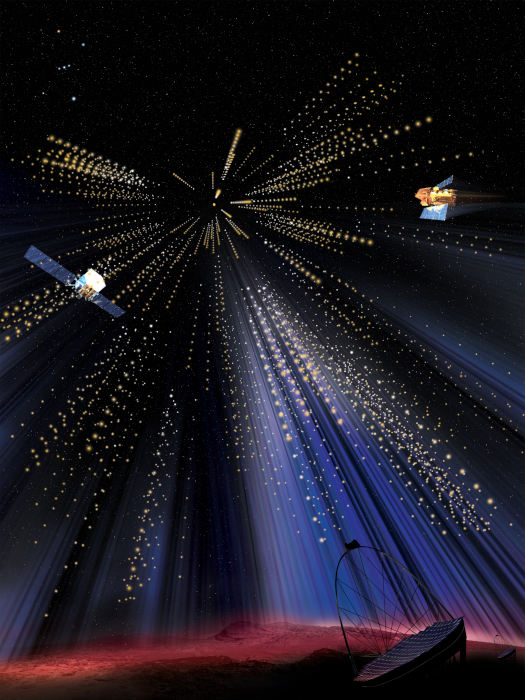
 Credit: NASA/Fermi and Aurore Simonnet, Sonoma State University
Credit: NASA/Fermi and Aurore Simonnet, Sonoma State University
MAGIC Burst
Imagine what would happen if a black hole suddenly formed at the center of a star. Astronomers believe that this actually happens at least a few times per week when some very massive stars die. When a very massive star runs out of fuel in its core region, the enormous mass of the star crushes the core, squeezing it to density higher than the
density of an atomic nucleus, forming an infinitely dense singularity surrounded by an event horizon. This is not good news for the star. Once a black hole forms at the center of a star, it starts to accrete the remaining outer layers of the star, forming an accretion disk around the black hole, and a powerful jet of extremely fast-movind charged particles and radiation. This jet blasts through the star, blowing the star away. When this beam is pointed in our direction, this stellar explosion produces an extremely powerful burst of gamma rays. Satellite observatories like the Fermi Gamma-ray Space Telescope and the Neil Gehrels Swift observatory have been discovering these bursts throughout the Universe, helping us understand how often black holes are formed. The illustration above shows a shower of gamma rays from a gamma-ray burst flooding the detectors on Fermi (the spacecraft on the left of the image) and Swift (on the right). Once localized by these satellites, astronomers are notified for follow-up observations by services like the Gamma-ray Coordinates Network/Transient Astronomy Network and the Astronomer's Telegrams, which distribute news of interesting gamma-ray bursts and other transient celestial events via the internet. On January 19, 2019, an unusual burst was seen by both Fermi and Swift. Fermi's Large Area Telescope showed that this burst was unusually energetic, generating higher-energy gamma-ray emission than any other burst seen by Fermi. After notification by the Swift and Fermi teams, the huge telescopes of the Major Atmospheric Gamma Imaging Cherenkov observatory, or MAGIC, were quickly pointed at the burst location. MAGIC is an observatory which is designed to detect the most energetic events in the Universe. MAGIC discovered that this particular burst produced radiation that was 10 times more energetic than seen by Fermi, making it the most energetic gamma-ray burst yet known.
Published: November 25, 2019
<
HEA Dictionary ● Archive
● Search HEAPOW
● Other Languages
● HEAPOW on Facebook
● Download all Images
● Education ● HEAD
>

Each week the HEASARC
brings you new, exciting and beautiful images from X-ray and Gamma ray
astronomy. Check back each week and be sure to check out the HEAPOW archive!
Page Author: Dr. Michael F. Corcoran
Last modified Tuesday, 27-Feb-2024 10:15:16 EST


